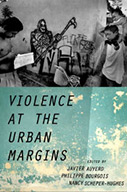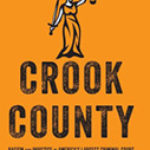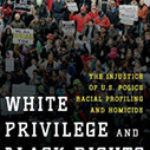Violence at the Urban Margins

Authors: Javier Auyero, Philippe Bourgois, and Nancy Scheper-Hughes
Publisher: New York: Oxford University Press, 2015. 352p.
Reviewer: Eduardo Moncada | January 2016
One of the paradoxes of late 20th century Latin America was the concurrence of national-level democratization, declining poverty, and skyrocketing levels of lethal violence at the subnational level – particularly within cities. Today the region is home to many of the world’s most violent cities (InSight Crime 2015). Delving beneath the level of the nation-state to explore these dynamics advances our understanding of the uneven territorial presence of the state, citizenship, and the rule of law (O’Donnell 1993). Violence at the Urban Margins contributes to this growing stream of research by examining the origins, dynamics, and consequences of urban violence.
The edited volume brings together established and emerging scholars united in their application of ethnographic methods to the study of urban violence; but differentiated by discipline, theoretical approach, and empirical focus. The book is divided into four sections: the first focuses on the “moral economy” of violence, the second on gender and masculinity, and the third on societal responses to violence. The final section features a pair of self-reflective essays by scholars who study violence, along with a postface on the links between urban violence and broader global political and economic trends. Overall, the book offers a fascinating immersion into the micro-dynamics of urban violence.
One of the volume’s notable features is its empirical breadth, which includes cases from across the Americas. Readers will find analyses of urban violence in Central and South America alongside studies set in Philadelphia and Los Angeles. A number of provocative similarities surface across these seemingly disparate cases, including the ways in which violence weakens and constructs social bonds, reconfigures norms and moral codes, and erodes state-society relations. What explains these analogous findings across such distinct empirical settings? A fine addition to the volume’s introductory chapter would have been more systematic reflection on these and other questions prompted by the similarity in findings across different contexts. Nonetheless, the volume’s unique empirical range highlights the potential theoretical dividends that might be derived from more explicit comparative analysis of violence in cities both within and across countries and regions.
The first section of the book uses the analytical lens of the moral economy of violence, defined as the “shared notion of what are appropriate and inappropriate economic practices” (Kilanski and Auyero 2015, 10), to unpack and contextualize the reciprocal relationships among violence, social norms, and moral orders. The analytic leverage afforded by this lens is especially evident in the chapter by Karandinos, Hart, Castrillo, and Bourgois. Drawing on data collected during a multi-year study of an illicit narcotics market in a North Philadelphia neighborhood, the authors offer nuanced insights into the links between violence and a broader political economy of deindustrialization, resource scarcity, and pronounced class and racial cleavages. The chapter provides a model of some of the ways in which scholars can link the micro-dynamics of violence at the individual, household, and neighborhood levels to macro-level political and economic processes that unfold far above the city-level — but which are nonetheless deeply embedded within the city.
In the third section, the book takes up the woefully understudied gender dimension of contemporary violence in Latin America. The two powerful chapters in this section help lay the groundwork for future research to continue unpacking the complex and sometimes counterintuitive ties between gender and masculinity, and varied forms of violence. In their chapter on cities in El Salvador and Rio de Janeiro (Brazil), Mo Hume and Polly Wilding call for relaxing the conceptual borders between public and private forms of violence. They use this as a first step toward destabilizing assumptions found in both the academic and policy literatures regarding the purportedly natural links among youth, violence, and masculinity. Adam Baird offers a novel analysis of community understandings of masculinity in a violent impoverished neighborhood in Medellin (Colombia). Baird effectively uses interviews and participant observation to explore the role of both lethal and sexual violence in self-assessments of masculine worth. But he also analyzes the rational logics that lead some women to forge ties with local gangs and establish what often become psychologically and physically abusive relationships with individual gang members.
Building on the above, the contributions in the fourth section examine the ways in which violence can spark a diverse range of societal responses. Ana Villareal extends research on the “city of walls” (Caldeira 2000) phenomenon by analyzing strategies used by socioeconomic elites in Monterrey (Mexico) to insulate themselves from varied forms of criminal violence, including limiting travel to well-coordinated caravans. Villareal points to these strategies and practices as evidence that violence also has the constructive capacity to prompt collective action and, in turn, strengthen social capital. In a similar vein, Zubillaga, Llorens, and Souto analyze the ways in which mothers in a violent neighborhood in Caracas (Venezuela) organize to confront and negotiate peace between warring local armed groups populated by their own sons and nephews. Alice Goffman’s contribution draws on the controversial research from her broader book (Sullivan 2015) to analyze the ways in which women in a Philadelphia neighborhood respond to local violence carried out by both their male partners and family members, and the police. Auyero and Kilanski draw on a granular analysis of violence in a poor neighborhood in Buenos Aires (Argentina) to inductively build a typology of societal responses to violence categorized along the dimensions of individual versus collective and violent versus nonviolent. Taken together, these chapters start to move us past an understanding of responses to violence as limited to withdrawal from social networks or engagement in vigilantism through the extra-legal use or threat of physical coercive force in response to alleged criminal acts. These chapters instead alert us to the wide variety of responses to violence, and the intended as well as unintended consequences they can have on life in the urban margins.
The volume’s final section contains two self-reflective essays on the challenges – both personal and professional – that scholars encounter in researching urban violence when using ethnographic methods. Randol Contreras provides a stirring narrative of the unexpected barriers and opportunities that his mixed racial and ethnic status generated as he researched racially and ethnically defined gangs in Los Angeles. And Nancy Scheper-Hughes takes readers back to Brazil to the site of her seminal anthropological study of “everyday violence” characterized by sharp socioeconomic inequalities, democratic deficiencies, and racial and paternalistic hierarchies (Scheper-Hughes 1992). Here, Scheper-Hughes reflects on the emergence of a death squad aligned with the local government in her former research site and how she came to collaborate in local judicial efforts to pursue the architects of the armed group. Taken together, these provocative essays highlight some of the complex ways in which violent research sites are both changed by and change researchers in dramatic and lasting ways. The final chapter in this volume is an engaging postface by Philippe Bourgois that discusses the varied links between urban violence and the broader global war on drugs and the spread of neoliberalism.
As should be clear by now, an obvious strength of this volume is its intense focus on the links between varied societal dynamics and urban violence, including patriarchal norms, racial tensions, gender, and socioeconomic inequality. The focus on societal dynamics, however, arguably comes at the expense of attention to politics. With the exception of the chapters by Scheper-Hughes and Villareal, local political actors are largely absent. This is particularly surprising given that the volume’s editors have each produced seminal studies on the ways in which both formal and informal politics pervades everyday life in violent urban margins (i.e., Auyero 2007; Bourgois 2003; Scheper-Hughes 1992).
How do formal political institutions and processes, including political parties and elections, intersect with the complex informal norms and moral orders of violence documented in the book? What are the effects of escalating levels and mutating forms of violence on the clientelist political networks long relied on to obtain basic goods and services? Is engagement with elected officials or political parties among the collective nonviolent strategies that individuals and communities can deploy in the face of urban violence? And if so, does the availability of this political strategy vary across dimensions of class, race, or gender? These and others questions about the ways in which politics both shapes and is shaped by violence in the urban margins are left unanswered.
In contrast, the state does appear in several of the book’s chapters, but primarily via its coercive apparatus — the police. There is little doubt that the police are a prominent extension of the state in marginal urban settings. And the emphasis in several chapters on extra-judicial violence by state security forces alludes to broader questions about the quality and meaning of democracy and citizenship in several of the empirical settings. Yet by using the police as a proxy for the entire state, various authors miss the opportunity to develop a more disaggregated approach to the state and, in turn, the roles played by distinct state institutions and actors in the dynamics of urban violence. How do social service agencies, for example, function in contexts of intense insecurity at the urban margins? Is their ability to connect to local communities regulated by the local armed actors that occupy several of the volume’s analyses? Disaggregating the state in the urban margins would enable us to have an even more nuanced understanding of how violence impacts pre-existing or fosters new intra-state cleavages and tensions. And pursuing these types of questions would allow for further exploration of the complex links between violence and the broader process of state building.
A final and related point that emerges from the book is how “community” is conceptualized. Much of the empirical analysis along this line focuses on the victims and protagonists of violence. And certainly this goes far toward advancing our knowledge of the lived experience of urban violence. But what if we were to expand the conceptualization of community to include individuals that reside within and form part of these communities, but are simultaneously part of these states, such as local party brokers? More attention to the ways in which violence links to these points of overlap between public and private networks within the urban margins represents a promising area for future research.
Violence at the Urban Margins is an important contribution to our understanding of the emerging dynamics of violence in cities across the Western Hemisphere. Overall, the empirical chapters are well-written and engaging ethnologies that offer us provocative and nuanced arguments. The book will and should be read widely by those interested in better understanding the complex and varied roles that violence plays in lives lived in the urban margins.
References
- Auyero, J. Routine Politics and Violence in Argentina: The Gray Zone of State Power. (Cambridge University Press, 2007).
- Bourgois, P. In Search of Respect: Selling Crack in El Barrio. (Cambridge University Press, 2003).
- Auyero, J., and Kilanski, K. "Managing in the Midst of Social Disaster." In Violence at the Urban Margins, edited by Auyero, J., Bourgois, P., Scheper-Hughes, N. (Oxford University Press, 2015): 189-211.
- Caldeira, T. City of Walls: Crime, Segregation, and Citizenship in São Paulo. (University of California Press, 2000).
- InSight Crime. “Latin America Dominates List of World’s Most Violent Cities.” Jan. 22, 2015. Available at: http://www.insightcrime.org/news-analysis/latin-america-dominates-list-of-worlds-most-violent-cities. Accessed on Nov. 7, 2015.
- O’Donnell, G. “On the State, Democratization and Some Conceptual Problems: A Latin American View with Glances at Some Postcommunist Countries.” World Development. 21:8 (1993), 1355-69.
- Scheper-Hughes, N. Death Without Weeping: The Violence of Everyday Life in Brazil. (University of California Press, 1992).
- Scheper-Hughes, N. “Death Squads and Vigilante Politics in Democratic Northeast Brazil.” In Violence at the Urban Margins, edited by Auyero, J., Bourgois, P., Scheper-Hughes, N. (Oxford University Press, 2015): 266-303.
- Sullivan, M. “Review of On the Run: Fugitive Life in an American City by Alice Goffman.” Criminal Law and Criminal Justice Books. March 2015.
Eduardo Moncada, Assistant Professor,
Department of Political Science,
Barnard College, Columbia University


